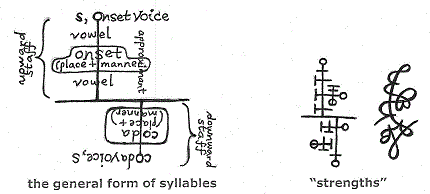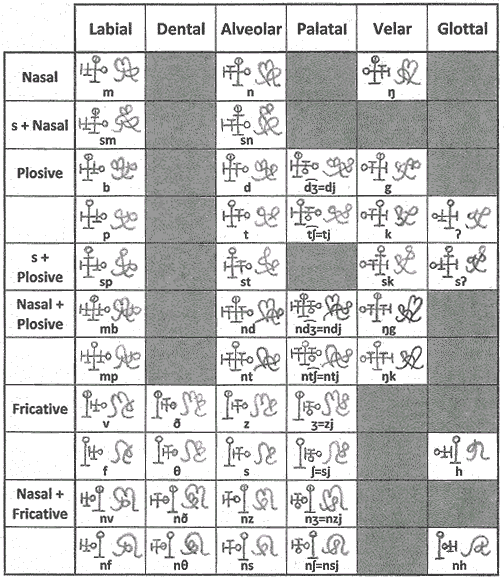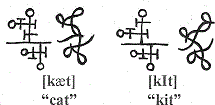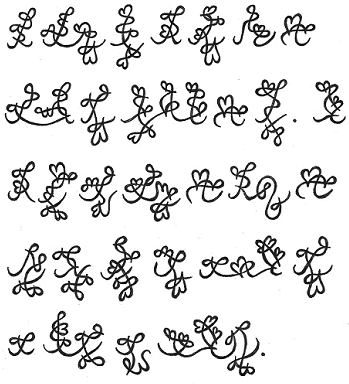
The Knot Alphabet was created in 2010 by Sheldon Ebbeler, a linguist and analyst of verbal behavior. The Knot Alphabet is technically not an alphabet*. It is an alphasyllabary, or abugida, which entails writing each syllable as a unit. Within these syllable units, the consonant portion is primary. The vowel portion is secondary though nonetheless required.
*Incidentally, the name "Knot Alphabet" was selected based not only on this pun but also on the fact that the script's aggregate forms resemble intricate knots of string.
Alphasyllabaries are more prevalent in languages with a simple CV (consonant + vowel) structure and those with fewer vowels, like Japanese. Creating an alphasyllabary for English should prove challenging. This is because English has more than the average amount of vowels and also a complex syllable structure: (s)C(A)V(A)(C)(C)(C). Ebbeler decided to create the Knot Alphabet as a challenge to the contention that it could not be accomplished. The Knot Alphabet works because, like Tengwarpt, it is featural. That is, distinctive features of the spoken sounds consistently correspond to distinct features of the written symbols. It is also phonetic, meaning that there exists a consistent correspondence between sounds and written symbols. This systematic nature of the Knot Alphabet is unlike many writing systems, including written English, making these other written languages very difficult to master.
The cursive structure of the script is based on 3 different forms: a point-form, a bump-form, and a loop-form. Because the curved shapes of the Knot Alphabet can get exceedingly intricate very quickly, especially to the untrained eye, a non-cursive version was created to help clarify distinctions between representations. These additional forms are intended only to aid with learning. Here are the cursive and non-cursive representations for the 3 basic forms:

These 3 forms are combined in multiple different ways to create more complex forms. For example, a shape like a cursive R can be created by crossing a bump-form with a point-form from the right side. A shape like a heart is created by crowning a loop-form with a downward point-form. (Incidentally, the latter form comprises the English semivowel [r].)

The particular forms created are not the only means different sounds are represented; the relation between forms is also significant. For example, the R form above can represent a p, b, m, k, or g, depending upon the shape's relation and orientation with respect to other shapes. This is parallel to how a stem and a circle can be combined in different ways to result in the lowercase letters b, p, q, and d for English.

Generally, English syllables consist of the following:
(Initial s) Onset Consonant (Semi-Vowel) Vowel (Semi-Vowel) (Coda Consonant(s)) (Final s)
The following form illustrates how syllables are generally represented using the Knot Alphabet. All syllables are written by beginning an upward staff. The center of this upward staff comprises the bulk of the onset consonant (namely, its place and manner of articulation). The vowel is written above and/or below the onset consonant's main form, depending upon what vowel it is. The voicing of the onset, and whether or not there is an initial s, is written at the very top portion of the staff. Semi-Vowels (namely, r, l, w, and y, including those that participate in blends and diphthong offglides) attach to the relevant site (i.e, replacing the blend consonant's point-form or the vowel's point-form). After the upward staff is complete, a downward staff starts to signify any and all coda consonants. Representation of the coda consonants is done in the same way as the onset consonants, though reversed, upside-down, and without vowel forms, of course. For a taste of how this all can come together, here is the Knot Alphabet representation for the word "strengths."

Now that we've summarized how syllables are generally captured with the Knot Alphabet, let's look at each of the specific components in more detail. The most fundamental piece of the syllabic form is the onset consonant. Each place of articulation for a consonant is indicated by a particular shape that attaches to the main (upward or downward) staff in a specific manner. Here are the primary shapes for 4 places of articulation for English (Labial, Alveolar, Velar, Glottal), as well as their Knot Alphabet representations. Note that each of these 4 place shapes consists of 3 basic parts: a base, a crossing point-form, and a top bump-form. These come together to fashion the familiar script R (from Figure 2) or its mirror image. Whether you've got the script R or its reflection, plus how the shape is oriented, determines exactly which place of articulation we are talking about.

The Dental place is represented by slightly modifying the Alveolar form, adding an inward point-form from the right of the bump-form. (If you were to represent a language other than English with the Knot Alphabet, and needed to create more places of articulation, the same modification (or something similar) could be applied to the other basic place shapes to yield even more forms.) The Palatal place is captured by blending an alveolar form with a [j] semi-vowel (i.e, the English "y"-sound). That is, "sh" is approximately [s] + [j] while "ch" is [t] + [j] and English "j" (as in "juice") is [d] + [j]. (See below on how semi-vowels attach for blends and diphthongs.) Finally, more specifically, it is worth mentioning that, for syllables that begin with a vowel, the glottal stop is used.

There are 3 basic manners of articulation for English consonants that are represented here using the Knot Alphabet: Nasal, Plosive, and Fricative. The Knot Alphabet also allows for certain combinations of these manners, in particular, Nasal+Plosive and Nasal+Fricative. These 5 manners of articulation are expressed by the location where the articulation place form intersects the main staff. For a specific example, consider labial consonants. The place form for labial consonants is a script R oriented downward (i.e, rotated 90 degrees clockwise). When the main staff crosses this down-facing R through its curved part, this is a nasal labial consonant, namely [m]. If the main staff crosses the R through its legs, however, this is a plosive consonant (i.e, [p] or [b]). Labial fricatives [f] and [v] are formed when the script R is made completely after the top bump-form of the main staff has been drawn; that is, there is no crossing of the R by the main staff and the R shape stems outward from the main staff. Shown below are the cursive and non-cursive forms for [m], [b], and [v]. At least initially, when learning how manners of articulation are signified with the Knot Alphabet, the non-cursive arrangements may be easier to disambiguate.
![phonemes [m], [b], and [v]](../images/writing/knot7.gif)
More generally, (1) nasals are formed by crossing the consonant's place form (with the main staff) between the top bump-form and the crossing point-form. (2) For plosives, this crossing occurs between the crossing point-form and the base. (3) Continuing this trend, when there is no crossing and the place form stems outward from the main staff, this signifies a fricative consonant. (NOTE: The general form for a fricative is distinct from a similar pattern, in which the place form stems inward, into the main staff. For more on this different form, see the discussion of the two complex forms for combined manners of articulation right below.)
There are 2 more complex forms that combine a pair of different manners of articulation into one shape. These are similar to the conjuncts of Devanagari. They are useful in representing two common sequences of two consonants sharing a place. (4) The nasal+plosive form is used to stand for pairs like [nd] and [mp]. It is simply a combination of the separate nasal and plosive forms, with the main staff piercing the place shape between two point-forms. (5) The nasal+fricative shape is useful for combinations like [ns] and [nv]. It is basically the opposite of the fricative pattern. In this case, the place form starts at one side of the main staff and stems inward (also without being intersected by the staff). Here are the representations for [mb] and [nv].
![representations for [mb] and [nv]](../images/writing/knot8.gif)
The 3rd and final aspect of a consonant to be indicated is its voicing. Voicing of the onset consonant is indicated on the top of the upward staff. A downward point-form, piercing the bump-form of the staff, indicates a voiced consonant. An unaltered bump-form designates an unvoiced consonant. Additionally, many English words have consonant clusters that begin with an initial-s (e.g, "stop"). Because this sound frequently occurs in this position, there is a special way to form this cluster, found in this general location shared by voicing. Specifically, a loop-form at the top of the upward staff denotes that the word has such an s-cluster. The following exemplify these 3 situations: voiced onset, unvoiced onset, and initial-s + unvoiced onset. Here we have [d], [t], and [st].
![[d], [t], and [st]](../images/writing/knot9.gif)
The following table is a summary of all the onset consonant forms we have discussed so far.

If you know a little bit about different manners of articulation, you might have noticed that we have not yet discussed approximant consonants. English has 4 approximants, or semi-vowels, that each has its own form. The liquids [r] and [l] consist of a loop-form that is or is not punctured on top by a downward point-form. In a similar fashion, the glides [w] and [j] (=English 'y') consist of a bump-form that is or is not punctured on top by a downward point-form.
![the glides [w] and [j]](../images/writing/knot11.gif)
When semi-vowels are a component of a blend of consonants, the semi-vowel form attaches to the consonant with which it is blended. Specifically, this semi-vowel form replaces the point-form of the consonant's R form. Shown below is the onset [k] without a semi-vowel contrasted to each of the four cases of blending.
![the onset [k] without a semi-vowel contrasted to each of the four cases of blending](../images/writing/knot12.gif)
When an English word begins with one of these approximant consonants, or starts with an s+approximant combination, the semi-vowels can be written as attaching to a glottal stop. (Recall that [s] + [j] = "sh" for our purposes. Additionally, English does not permit an [s] + [r] combination so this form conveniently represents the English cluster "shr.")
Vowels are an essential component of the typical English syllable. Vowels are generally formed by attaching left- or right-facing point-forms to the main staff. These point-forms themselves, however, are not the only significant aspect of a particular vowel; the specific spatial relation with respect to the onset consonant is important. For example, if a right-facing point-form is beneath the onset consonant, this signifies the short-a vowel (as in the word "cat"). Conversely, if the same right-facing point-form is found above the onset consonant, this is the short-I vowel (as in the word "kit").

For natural alphasyllabaries that represents vowel diacritics in a similar fashion, consider Brāhmī and Tibetan. Another case is Redjang. With this script, a dot to the left of a consonant akshara signifies the vowel [i] while the same dot placed underneath is a [u].
Short vowels generally consist of one, or sometimes two, point-forms coming from the left or right direction, above or below the onset consonant. Long vowels are treated like diphthongs, for which an offglide [j] (i.e, a y-sound), [w], or [r] attaches to the relevant vowel. Thus, for example, [i] is given by [I] + [j] and [e] is formed combining [E] + [j]. The chart presented here illustrates how to add each of all the possible English vowels to the phoneme [k] as a sample onset consonant.
![how to add each of all the possible English vowels to the phoneme [k] as a sample onset consonant](../images/writing/knot14.gif)
If an onset consonant ever occurs without a vowel, the default vowel is the schwa (=a neutral mid-central vowel, as found starting the word "about"). Note, however, that there is an alternative full form for this vowel as well.
When syllables end in a consonant, or a string of consonants, these consonants comprise the syllable's coda. With the Knot Alphabet, coda consonants are written after the upward staff (of onset consonants plus vowels) has been completed. Coda consonants are implemented in a similar fashion to onset consonants; place, manner, and voicing of the consonant(s) are treated identically. The only exception with coda consonants is that they are done on a subsequent downward staff. This down-facing staff is just like an upward staff that has been rotated 180 degrees. One significant consequence of this rotation is that consonant forms appear to be facing the opposite direction. This is simply because (onset and coda) consonants are always fully defined by the relationship between their place form with respect to the staff. Another significant observation is that, because the staff is upside-down, the consonants are written in reverse. Here we compare an onset [g], as in "goat," to a coda [g], as in "dog."
![comparison of an onset [g], as in 'goat', to a coda [g], as in 'dog'.](../images/writing/knot15.gif)
If there is more than one coda consonant, they are written in the order of how they are spoken, from the base of the downward staff down. A final [s], or [z], can be included in the analogous location, i.e, at the end of the staff. For an example of a complex coda, revisit the figure detailing the Knot Alphabet representation for the word "strengths."

All human beings are born free and equal in dignity and rights. They
are endowed with reason and conscience and should act towards one another
in a spirit of brotherhood.
(Article 1 of the Universal Declaration of Human Rights)
Funnish, Knot alphabet, Tengwarpt
For more information about the Knot Alphabet, or other scripts developed by the designer, please contact Sheldon Ebbeler at sheldonebbeler[at]yahoo[dot]com
Funnish, Knot alphabet, Tengwarpt, Uriovakiro
Constructed scripts for: Ainu | Arabic | Chinese languages | Dutch | English | Hawaiian | Hungarian | Japanese | Korean | Lingala | Malay & Indonesian | Persian | Tagalog / Filipino | Russian | Sanskrit | Spanish | Taino | Turkish | Vietnamese | Welsh | Other natural languages | Colour-based scripts | Tactile scripts | Phonetic/universal scripts | Constructed scripts for constructed languages | Adaptations of existing alphabets | Fictional alphabets | Magical alphabets | A-Z index | How to submit a constructed script
[top]
You can support this site by Buying Me A Coffee, and if you like what you see on this page, you can use the buttons below to share it with people you know.

If you like this site and find it useful, you can support it by making a donation via PayPal or Patreon, or by contributing in other ways. Omniglot is how I make my living.
Note: all links on this site to Amazon.com, Amazon.co.uk
and Amazon.fr
are affiliate links. This means I earn a commission if you click on any of them and buy something. So by clicking on these links you can help to support this site.
[top]